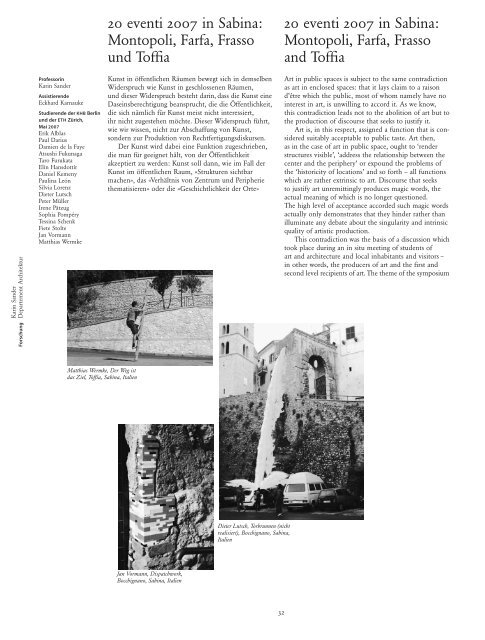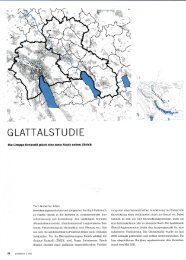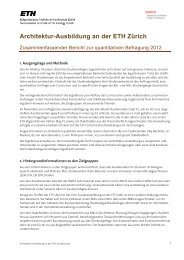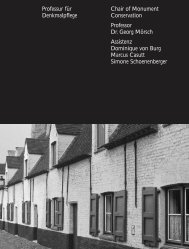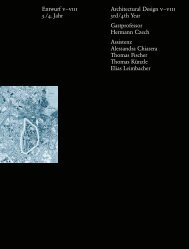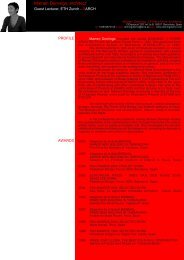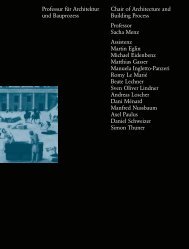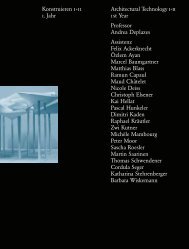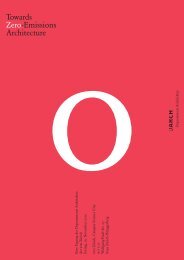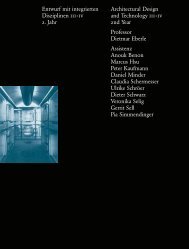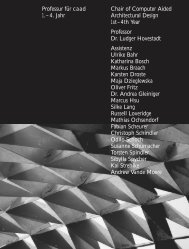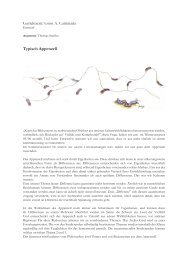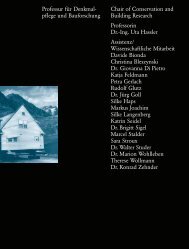Jahrbuch PDF (63MB) - ETH Zurich - ETH Zürich
Jahrbuch PDF (63MB) - ETH Zurich - ETH Zürich
Jahrbuch PDF (63MB) - ETH Zurich - ETH Zürich
Erfolgreiche ePaper selbst erstellen
Machen Sie aus Ihren PDF Publikationen ein blätterbares Flipbook mit unserer einzigartigen Google optimierten e-Paper Software.
Karin Sander<br />
Forschung Departement Architektur<br />
Professorin<br />
Karin Sander<br />
Assistierende<br />
Eckhard Karnauke<br />
Studierende der KHB Berlin<br />
und der <strong>ETH</strong> <strong>Zürich</strong>,<br />
Mai 2007<br />
Erik Alblas<br />
Paul Darius<br />
Damien de la Faye<br />
Atsushi Fukunaga<br />
Taro Furukata<br />
Elín Hansdottír<br />
Daniel Kemeny<br />
Paulina León<br />
Silvia Lorenz<br />
Dieter Lutsch<br />
Peter Müller<br />
Irene Pätzug<br />
Sophia Pompéry<br />
Tessina Schenk<br />
Fiete Stolte<br />
Jan Vormann<br />
Matthias Wermke<br />
Matthias Wermke, Der Weg ist<br />
das Ziel, Toffia, Sabina, Italien<br />
20 eventi 2007 in Sabina:<br />
Montopoli, Farfa, Frasso<br />
und Toffia<br />
Kunst in öffentlichen Räumen bewegt sich in demselben<br />
Widerspruch wie Kunst in geschlossenen Räumen,<br />
und dieser Widerspruch besteht darin, dass die Kunst eine<br />
Daseinsberechtigung beansprucht, die die Öffentlichkeit,<br />
die sich nämlich für Kunst meist nicht interessiert,<br />
ihr nicht zugestehen möchte. Dieser Widerspruch führt,<br />
wie wir wissen, nicht zur Abschaffung von Kunst,<br />
sondern zur Produktion von Rechtfertigungsdiskursen.<br />
Der Kunst wird dabei eine Funktion zugeschrieben,<br />
die man für geeignet hält, von der Öffentlichkeit<br />
akzeptiert zu werden: Kunst soll dann, wie im Fall der<br />
Kunst im öffentlichen Raum, «Strukturen sichtbar<br />
machen», das «Verhältnis von Zentrum und Peripherie<br />
thematisieren» oder die «Geschichtlichkeit der Orte»<br />
Jan Vormann, Dispatchwork,<br />
Bocchignano, Sabina, Italien<br />
Dieter Lutsch, Torbrunnen (nicht<br />
realisiert), Bocchignano, Sabina,<br />
Italien<br />
32<br />
20 eventi 2007 in Sabina:<br />
Montopoli, Farfa, Frasso<br />
and Toffia<br />
Art in public spaces is subject to the same contradiction<br />
as art in enclosed spaces: that it lays claim to a raison<br />
d’être which the public, most of whom namely have no<br />
interest in art, is unwilling to accord it. As we know,<br />
this contradiction leads not to the abolition of art but to<br />
the production of discourse that seeks to justify it.<br />
Art is, in this respect, assigned a function that is considered<br />
suitably acceptable to public taste. Art then,<br />
as in the case of art in public space, ought to ‘render<br />
structures visible’, ‘address the relationship between the<br />
center and the periphery’ or expound the problems of<br />
the ‘historicity of locations’ and so forth – all functions<br />
which are rather extrinsic to art. Discourse that seeks<br />
to justify art unremittingly produces magic words, the<br />
actual meaning of which is no longer questioned.<br />
The high level of acceptance accorded such magic words<br />
actually only demonstrates that they hinder rather than<br />
illuminate any debate about the singularity and intrinsic<br />
quality of artistic production.<br />
This contradiction was the basis of a discussion which<br />
took place during an in situ meeting of students of<br />
art and architecture and local inhabitants and visitors –<br />
in other words, the producers of art and the first and<br />
second level recipients of art. The theme of the symposium


